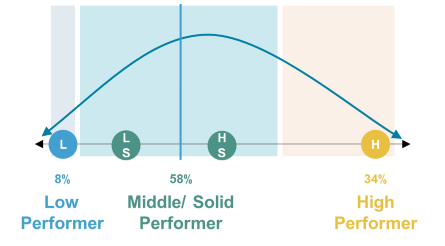Differentiating Staff Performance
How do we get people to do great things? We must have continuous conversations with those we lead. These conversations vary from relationship development to providing feedback for improvement. Research indicates that employees want to improve their performance. This improvement comes about when specific, timely feedback is provided. The feedback is accepted in a positive way when the leader has first developed a relationship with the employee. The leader knows the employee and customizes the feedback for that person to support the best opportunity for improvement.
For us to provide feedback to appropriately support varying performance levels, leaders assess where employees fall on a performance curve. Differentiating and placing staff on the performance curve is fluid. The expectation is for performance to improve as feedback and development is provided by the leader. Placement on the performance curve also helps a leader consider the type of performance conversation needed to help an employee improve.







